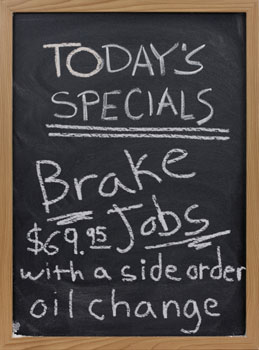Once upon a time, I received a lot of interesting letters…and, an equally interesting number of phone calls. These days, I seem to receive fewer letters, just about the same number of equally interesting phone calls and a significantly greater number of extremely interesting e-mails, perhaps because e-mails are immediate and easier to send.

These messages touch on any number of subjects, with the majority of them in response to something I’ve written, something that struck a nerve or was too close to home.
A growing number of these e-mails, calls and letters, however, look for answers and opinions.
Opinions, I have in abundance! And, for the most part, I’m not the least bit hesitant to share them. Ask anyone who knows me — and “anyone” would most assuredly include all of you!
Answers are a bit more difficult because they demand both knowledge and understanding of the subject in question, as well as a willingness to take what may have previously been reserved as an opinion to an entirely new and different level.
Frankly, I’m always flattered that anyone would be interested in what I think or what I have to say about this industry, our place in it or anything else for that matter. Perhaps, that’s why I take these e-mails, letters and calls as seriously as I do. My feeling is that if you are motivated enough to write or call, either by curiosity or by pain, I should be responsible enough to respond.
While not always successful, I try to answer everyone, and those of you who have called or written and received a response, either “instant” or “eventual,” know this. I guess you should also know that instant is usually reserved more for opinions than it is for answers. Opinions are like belly-buttons, everyone has got at least one and most of us are not only willing to share them — we are downright eager! Sometimes so eager, we make a point of offering an opinion even before it’s solicited. I know I’ve been guilty of this myself. And, while I’ve built a career around offering opinions before they are requested — that is, after all, what most columns are, I can assure you it can be and often is dangerous!
Answers, on the other hand, take time. They require at least some knowledge of the subject; a modicum of understanding with regard to the question; and the time, energy, resources and willingness to get involved and respond. This, too, can be and often is dangerous. First, and perhaps most significant, is the simple fact the person searching for an answer might not like the one you have to offer and the rejection and/or castigation that generally follows can be painful. Second, and perhaps not so obvious, is the fact that responding to someone else’s question can and often will force you to confront your own beliefs: what you think or already “know” to be true about the subject in question.
What I find so fascinating about all of this is that by virtue of the question, neither the person asking it, nor the person being asked to answer, will ever be the same. It’s all a matter of Purpose, Beliefs, Information and Behavior.
Purpose is the “why” you do something; the reason behind the investment you make or the effort involved in attempting anything. Beliefs are how you “feel” about that something; what drives you to act. Behavior is the action you are willing to take in order to accomplish your purpose; actions based upon those beliefs. Information is the wild card, a game-changer by definition and by its very nature.
Why? How?
It’s easy…
Once you have been confronted with new information (especially information relevant to your Purpose, Beliefs, Actions or Behaviors), once you have been exposed to new ideas or a different perspective and paused long enough to consider or reflect, you are forever changed. You can and never will be the same, and you can’t go back. Once that new information has been integrated or assimilated, what you think and how you feel — about anything and everything — reflects what you’ve learned; what you now know and have experienced, and by that exposure is greater than everything you knew, thought or felt before.
I received an e-mail just a few days ago that could serve as a great example of how we learn, grow and evolve; a great example of how all this plays out in reality. The author is a long-time reader and a veteran automotive service professional with experience in virtually every segment of the service industry. He is currently managing a franchise outlet and was writing to ask if I knew of any industry articles on “loss-leader” advertising and/or the kind of “menu pricing” environment in which it normally flourishes.
I wasn’t aware of any articles on the subject; at least none that addressed that specific aspect of pricing, but I was intrigued. Perhaps, because I’m not a big fan of what is generally known in marketing circles as “Product & Price-Point” advertising. I’m not a fan for a number of reasons, not the least of which is that product and price are rarely what the motorist is looking for. The motorist generally wants security and confidence. The motorist is generally searching for solutions. That isn’t to say loss leaders and/or menu pricing can’t, won’t or doesn’t work…at least for some. I’m just saying it doesn’t work for me.
Before I formulated a response, however, and took this query to the next level, I needed to know if that response called for an answer or an opinion. I needed to know exactly what the author was looking for, so I wrote back asking for more information about what prompted the question in the first place. It seems that his employers were being told that an aggressive advertising program focusing on a $69.95 brake “special” would lead to increased traffic — increased car count — and a $250 Average Repair Order. (We can talk about those goals and objectives in another column if you’d like!)
The problem was that common sense and years of experience in the industry were telling him it could only lead to trouble. And, frankly, I had to agree. But, as our dialogue progressed, I sensed a need for answers and not just opinions.
I called my editors here at Babcox and asked if we had any articles on menu pricing or loss-leader advertising. I went online and checked the forums on iATN and other online resources. I checked my own archived
e-mails as well, and there just wasn’t a lot there.
The editors felt that most professional shop owners and managers for a number of reasons frowned upon this practice. First, because it combines a compellingly low price with a non-specific description of service, like: “Brake Job, $69.95,” it can be misleading because most motorists are not sophisticated enough to formulate the right questions to ask, like “What is included? What isn’t…”
Second, because it generally advertises a service at or below cost, it implies there will be — at least at some point — an attempt to move the motorist toward a “better” product at a “slightly” higher price. A kind of: “Well, yes. That is the price for THAT brake service and THOSE brake pads. But, you wouldn’t want to have to depend upon THOSE pads to stop your car if you had your wife, kids, mother or — fill in the blank — in the car!” A kind of Bad, Good, Better, Best pricing menu that finds its way to the evening news all too often.
Third, because the description “Brake Job” or “Brake Service” is often nebulous at best, and downright misleading at worst. It can and often does result in “Buyer’s Remorse,” something none of us needs to deal with.
The information on iATN mirrored what our editors had to say almost exactly, as did my own archived
e-mails. But what does it all mean in terms of Purpose, Beliefs, Behavior and Action?
It starts with a simple question: What is our purpose with regard to the people we serve: the motoring
public, our customers and clients? Why are we here? And, what are we here to accomplish?
If our purpose is solely to make money, menu pricing and loss-leader advertising almost make sense. Both are effective at drawing in at least two distinct and well-defined types of clients: price-shoppers and the unsuspecting.
Price-shoppers are people who search and struggle to find the lowest price for anything almost as if it were a game. And, I would suggest to you these folks are anything but clients. The unsuspecting are those individuals who genuinely cannot tell the difference between the cost of a product or service and value; that which you receive for the money you spend.
If our only purpose is to make money, then menu pricing and loss-leader advertising would be consistent with both our beliefs and our behaviors.
If, on the other hand, our purpose is to keep our customers safe, to increase the service life of their vehicles and to reduce their overall service cost — we have to wonder where tactics and policies like menu pricing and loss-leader advertising fit in. Or, at least, I have to because they wouldn’t be consistent with either our purpose or our beliefs, which would then demand a different set of behaviors.
But, that’s just my opinion based upon what I know, the research I’ve done, the information I’ve been exposed to, the experiences I’ve had and my willingness to continually challenge my own beliefs and belief systems.
The real question is, what do you think about menu pricing and loss-leader advertising? Perhaps more important, what do you think our overall purpose is? Is there an over-arching, over-riding principle that drives the service industry — at least, for the majority of us? Is it all about the money? Or, is it somewhere in between?
Are menu pricing and loss-leader advertising “good” for the industry, good for us? Or, is it counter-productive? And, if it is counter-productive, if it is contrary to our purpose, what can we do to change the beliefs that make it acceptable, and then change the behaviors associated with those beliefs?
How do you feel about menu pricing and loss-leader advertising? What’s your purpose? Is your behavior consistent with your beliefs? Let me know what you think and how you feel about this and other important questions (you can e-mail me at [email protected]). Consider it a first step in mapping the service industry’s collective DNA. Let’s begin an exploration of this important issue and all the other important questions and issues confronting our industry today. And, who knows, when it’s all over, there just may be fewer questions and issues for all of us to contemplate. If nothing else, at least we will all know what’s on the automotive service industry menu.













